A Digital Denoising Method Based on Data Frequency Statistical Filtering
Abstract
1. Introduction
2. Image Denoising Method Based on Probability Statistics
2.1. Reading and Storing the Original Image
2.1.1. Reading the Original Image
2.1.2. Storing the Original Image
2.2. Modular Processing
2.3. Data Frequency Statistics
2.4. Noise Screening and Processing
2.4.1. Noise Screening
2.4.2. Noise Processing
2.5. Composite Image
3. Experiment
3.1. Experimental Conditions
3.2. Filtering Effect and Comparison
3.2.1. Filtering Methods and Evaluation Criteria
3.2.2. Low-Density Random Value Impulse Noise Experiment
- Window size: 5 × 5;
- Minimum modular units: 5%—12, 10% and 15%—20;
- Data frequency threshold: 5%—0.12, 10%—0.16, 15%—0.18;
- Times filtered: 2;
- Threshold selected by the method: 5%—0.08, 10% and 15%—0.12.
3.2.3. Medium-Density Random Value Impulse Noise Experiment
- Window size: 5 × 5;
- Minimum modular units: 20%—20, 30% and 40%—24;
- Data frequency threshold: 20%—0.16, 30%—0.24, 40%—0.32;
- Times filtered: 3;
- Threshold selected by the method: 20%, 30%, and40%—0.12.
4. Conclusions
- Through the experiment, it can be seen that the proposed method can effectively filter random impulse noise of medium and low density, and better preserve both image detail and quality. The noise reduction effect is superior to other filtering methods at each density, in terms of both subjective and objective evaluation.
- The structural similarity, SSIM, of the new method proposed in this paper can be maintained above 0.9 under low-density noise conditions and above 0.75 under medium-density conditions, which is much better than other methods. The peak signal-to-noise ratio (PSNR) also demonstrates better stability than other methods at all densities, and the higher the noise density, the more obvious the advantage.
- The method also has the following characteristics: an adjustable noise reduction effect, high operation efficiency, simple operation steps, shorter operation time, less resource occupation, etc. Therefore, it can realize efficient image processing and has certain practical value.
Author Contributions
Funding
Institutional Review Board Statement
Informed Consent Statement
Data Availability Statement
Acknowledgments
Conflicts of Interest
References
- Tropp, J.A. Just relax: Convex programming methods for identifying sparse signals in noise. IEEE Trans. Inf. Theory 2006, 52, 1030–1051. [Google Scholar] [CrossRef]
- Chan, R.H.; Ho, C.W.; Nikolova, M. Salt-and-Pepper noise removal by median-type noise detectors and detail-preserving regularization. IEEE Trans. Image Process. 2005, 14, 1479–1485. [Google Scholar] [CrossRef] [PubMed]
- Yi, H. Research on the Improvement of Papper and Salt Noise Identification and Filtering Algorithm. Master’s Thesis, Beijing University of Civil Engineering and Architecture, Beijing, China, 2020. [Google Scholar]
- Gupta, V.; Chaurasia, V.; Shandilya, M. Random-valued impulse noise removal using adaptive dual threshold median filter. J. Vis. Commun. Image Represent. 2015, 26, 296–304. [Google Scholar] [CrossRef]
- Tukey, J. Nonlinear (Nonsuperposable) Methods for Smoothing Data. In Proceedings of the Congress Record EASCON, Washington, DC, USA, 7–9 October 1974; pp. 673–681. [Google Scholar]
- Brownrigg, D.R. The weighted median filter. Commun. ACM 1984, 27, 807–818. [Google Scholar] [CrossRef]
- Sun, T.; Gabbouj, M.; Neuvo, Y. Adaptive L-filters with applications in signal and image processing. Signal Process. 1994, 38, 331–344. [Google Scholar] [CrossRef]
- Bao, L.; Panetta, K.; Agaian, S. Single Image Based Random-Value Impulse Noise Level Estimation Algorithm. In Proceedings of the Computing Conference, London, UK, 10–12 July 2018; pp. 1306–1318. [Google Scholar]
- Yinyu, G.; Kim, N. A Study on Image Restoration Algorithm in Random-Valued Impulse Noise Environment. J. Inf. Commun. Converg. Eng. 2011, 9, 331–335. [Google Scholar] [CrossRef][Green Version]
- Liu, S.; Yu, Z.D. An Improved Method of Switching Median Filter. Microcomput. Appl. 2009, 30, 1–6. [Google Scholar]
- Erkan, U.; Gökrem, L. A new method based on pixel density in salt and pepper noise removal. Turk. J. Electr. Eng. Comput. Sci. 2018, 26, 162–171. [Google Scholar] [CrossRef]
- Pritamdas, K.; Singh, K.M.; Singh, L.L. An adaptive switching filter based on approximated variance for detection of impulse noise from color images. Springerplus 2016, 5, 1969. [Google Scholar] [CrossRef]
- Ashpreet; Biswas, M. Impulse Noise Detection and Removal Method Based on Modified Weighted Median. Int. J. Softw. Innov. 2020, 8, 38–53. [Google Scholar] [CrossRef]
- Ma, C.; Lv, X.; Ao, J. Difference based median filter for removal of random value impulse noise in images. Multimed. Tools Appl. 2019, 78, 1131–1148. [Google Scholar] [CrossRef]
- HosseinKhani, Z.; Hajabdollahi, M.; Karimi, N.; Soroushmehr, R.; Shirani, S.; Najarian, K.; Samavi, S. Adaptive Real-Time Removal of Impulse Noise in Medical Images. J. Med. Syst. 2018, 42, 216. [Google Scholar] [CrossRef] [PubMed]
- Tan, X.; Jiang, J.; Zha, D. Threshold Switch Filter Designing and its Realization in Image Denoising. Modul. Mach. Tool Autom. Manuf. Tech. 2011, 10, 49–52. [Google Scholar]
- Wenjuan, L.; Jun, C.; Yonggang, Z.; Xinmin, S. Research of Medical Image Denoising Based on Improved Weighted Mean Filtering. J. Liaoning Univ. (Nat. Sci. Ed. ) 2022, 49, 30–35. [Google Scholar]
- Zhang, S.; Karim, M.A. A new impulse detector for switching median filters. IEEE Signal Process. Lett. 2002, 9, 360–363. [Google Scholar] [CrossRef]
- Aizenberg, I.N.; Butakoff, C. Effective impulse detector based on rank-order criteria. IEEE Signal Process. Lett. 2004, 11, 363–366. [Google Scholar] [CrossRef]
- Peng, Q.; Runtao, D. Ordering Threshold Switching Median Filter. J. Image Graph. 2004, 9, 412–416. [Google Scholar]
- Zhenggeng, Q.; Shaoqing, N. Research on an Improved Adaptive Weighted Median Filtering Algorithm. Comput. Technol. Dev. 2018, 28, 86–90. [Google Scholar]
- Tsuda, K.; Fujisawa, T.; Ikehara, M.; IEEE. Random-valued Impulse Noise Removal Using Non-local Search for Similar Structures and Sparse Representation. In Proceedings of the International Workshop on Advanced Image Technology (IWAIT), Chiang Mai, Thailand, 7–9 January 2018. [Google Scholar]
- Jin, Q.; Bai, L.; Grama, I.; Liu, Q.; Yang, J. Removing Random-Valued Impulse Noise with Reliable Wight. Inverse Probl. Imaging 2020, 14, 171–203. [Google Scholar] [CrossRef]
- Peixuan, Z. A New Adaptive Weighted Mean Filter for Salt and Pepper Noise. Master’s Thesis, East China Normal University, Shanghai, China, 2015. [Google Scholar]
- Akkoul, S.; Lédée, R.; Leconge, R.; Harba, R. A New Adaptive Switching Median Filter. IEEE Signal Process. Lett. 2010, 17, 587–590. [Google Scholar] [CrossRef]
- Qian, X. Research on Filtering Algorithm of Random Value Impulse Noise. Master’s Thesis, Anqing Normal University, Anhui, China, 2019. [Google Scholar]
- Sun, X.; Song, S.G. Median Filter Image Denoising Algorithm under Point Detection. China Comput. Commun. 2019, 2, 52–54. [Google Scholar]
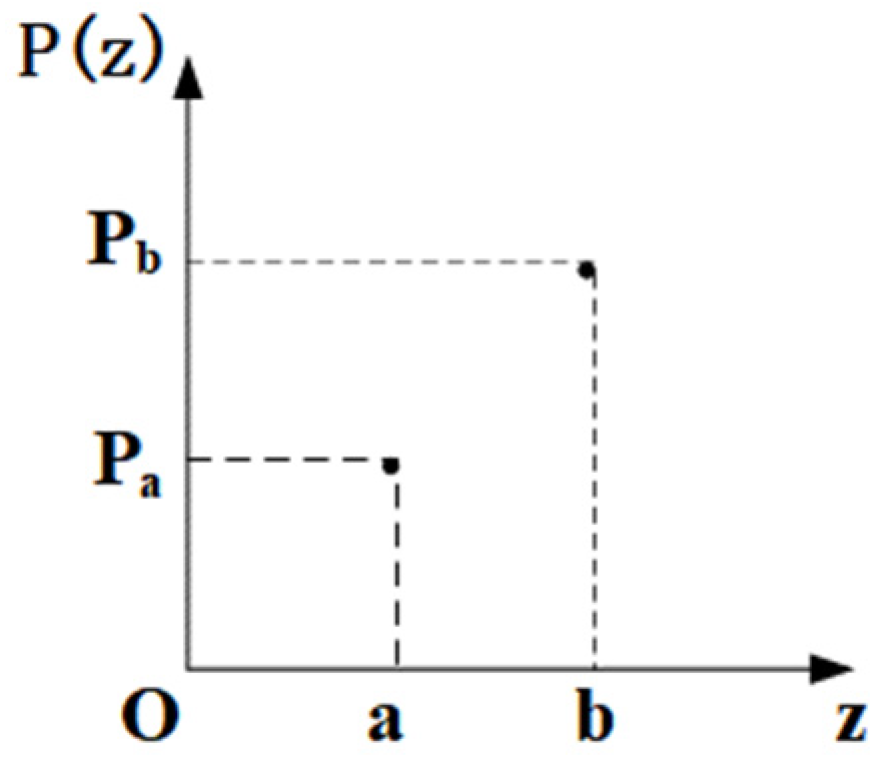
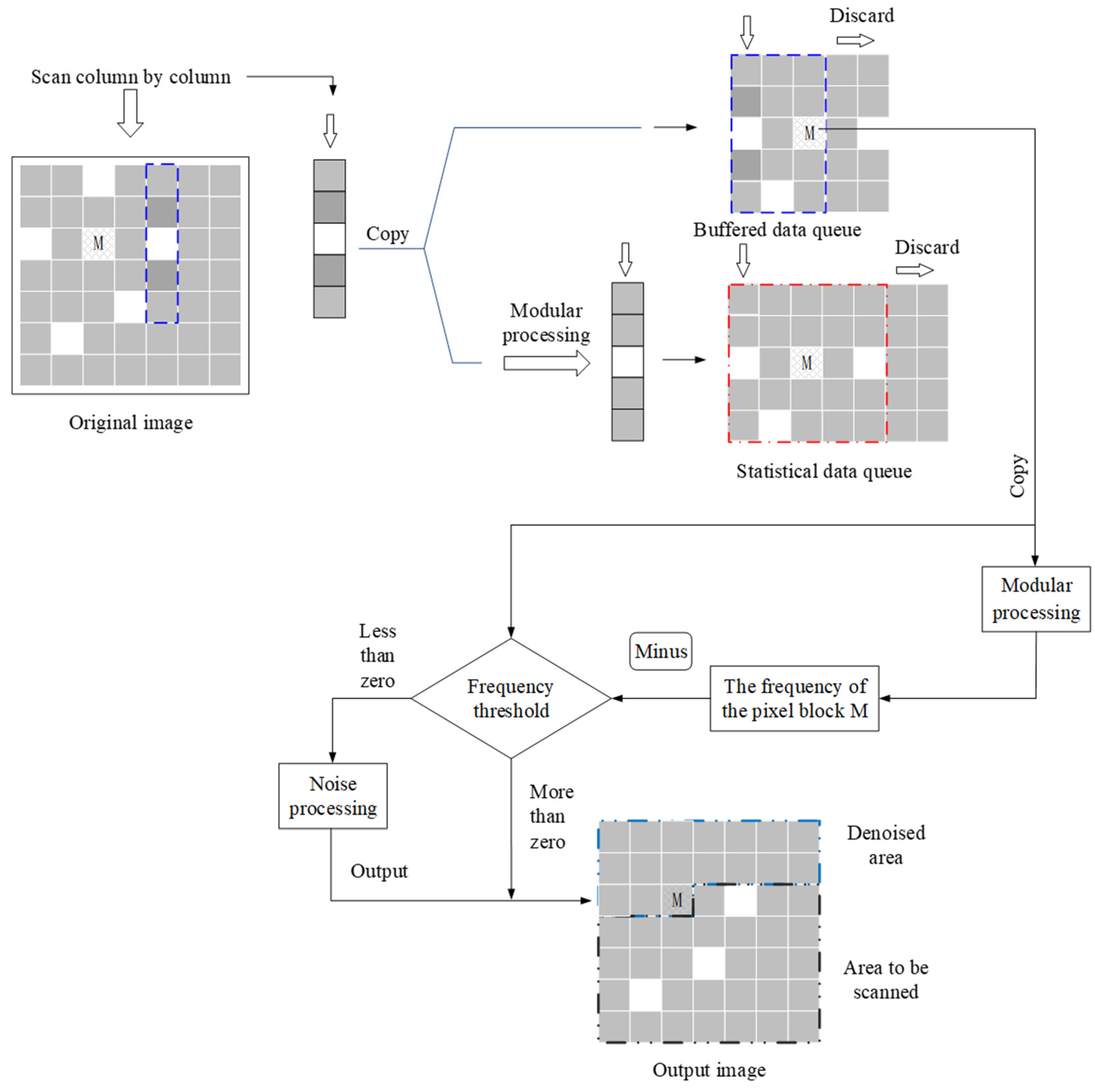
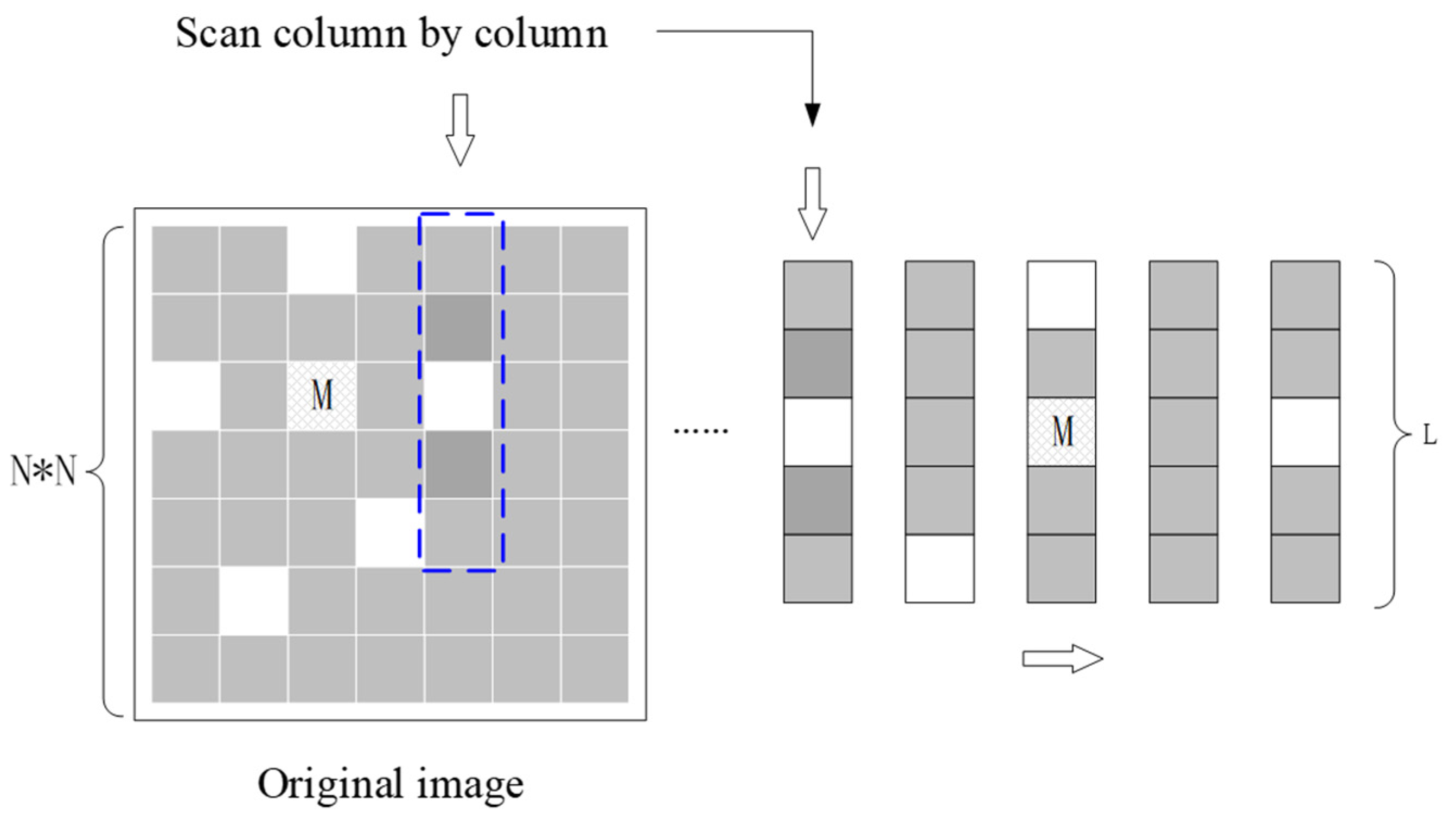
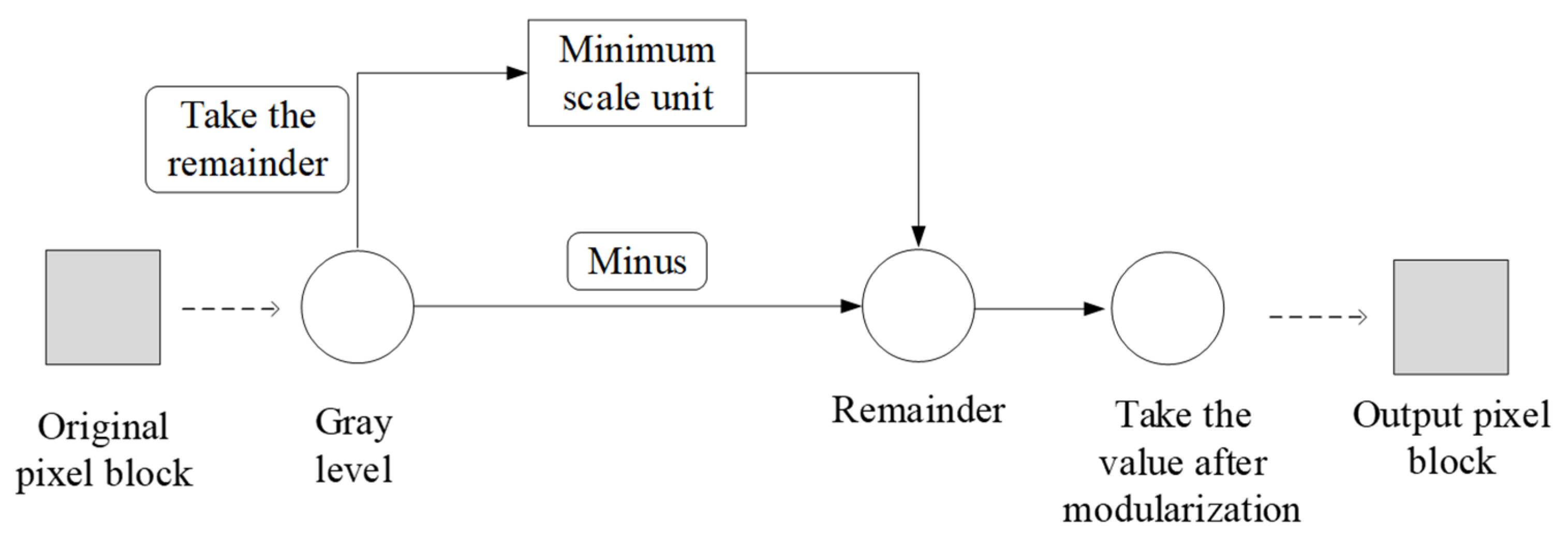

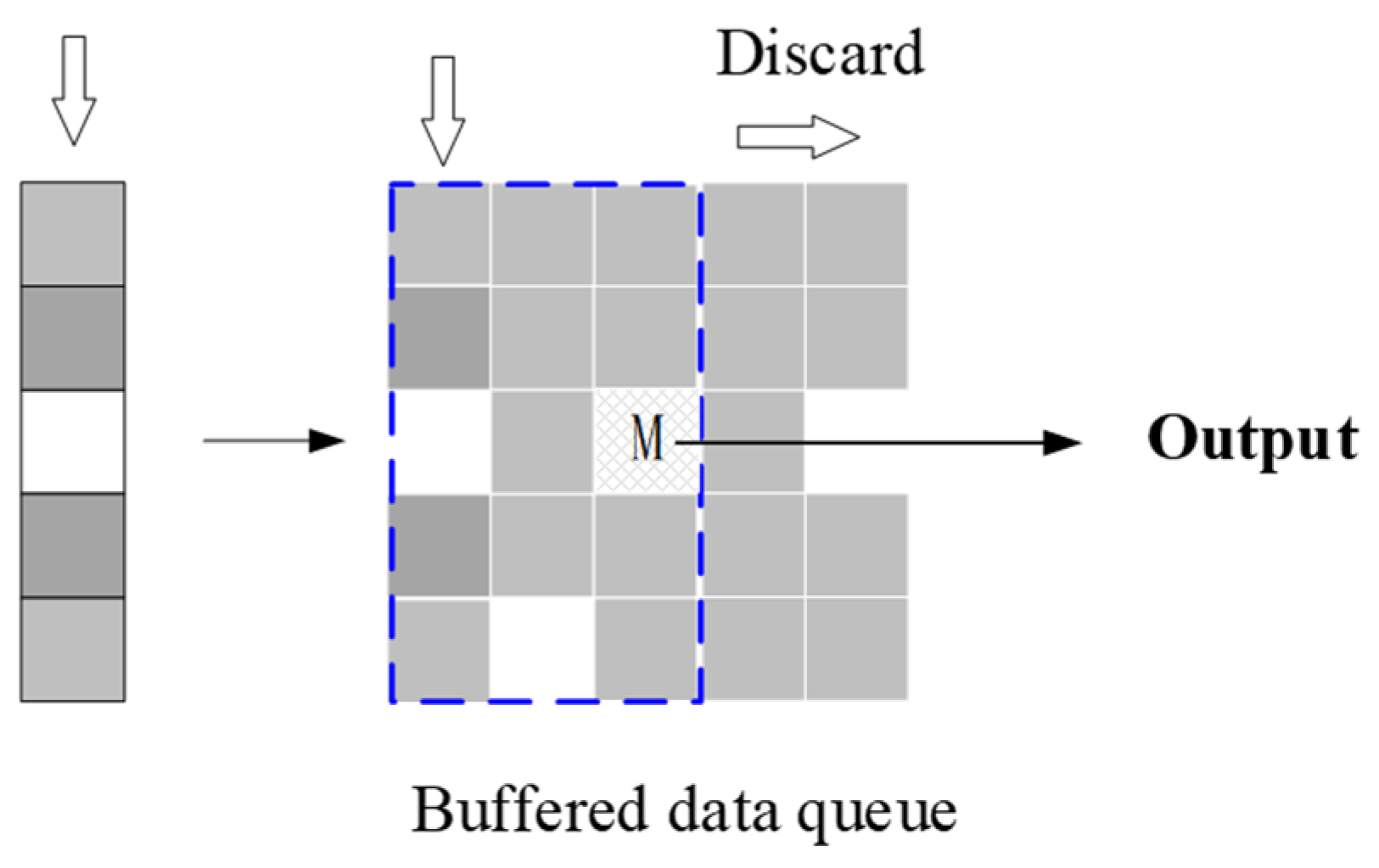
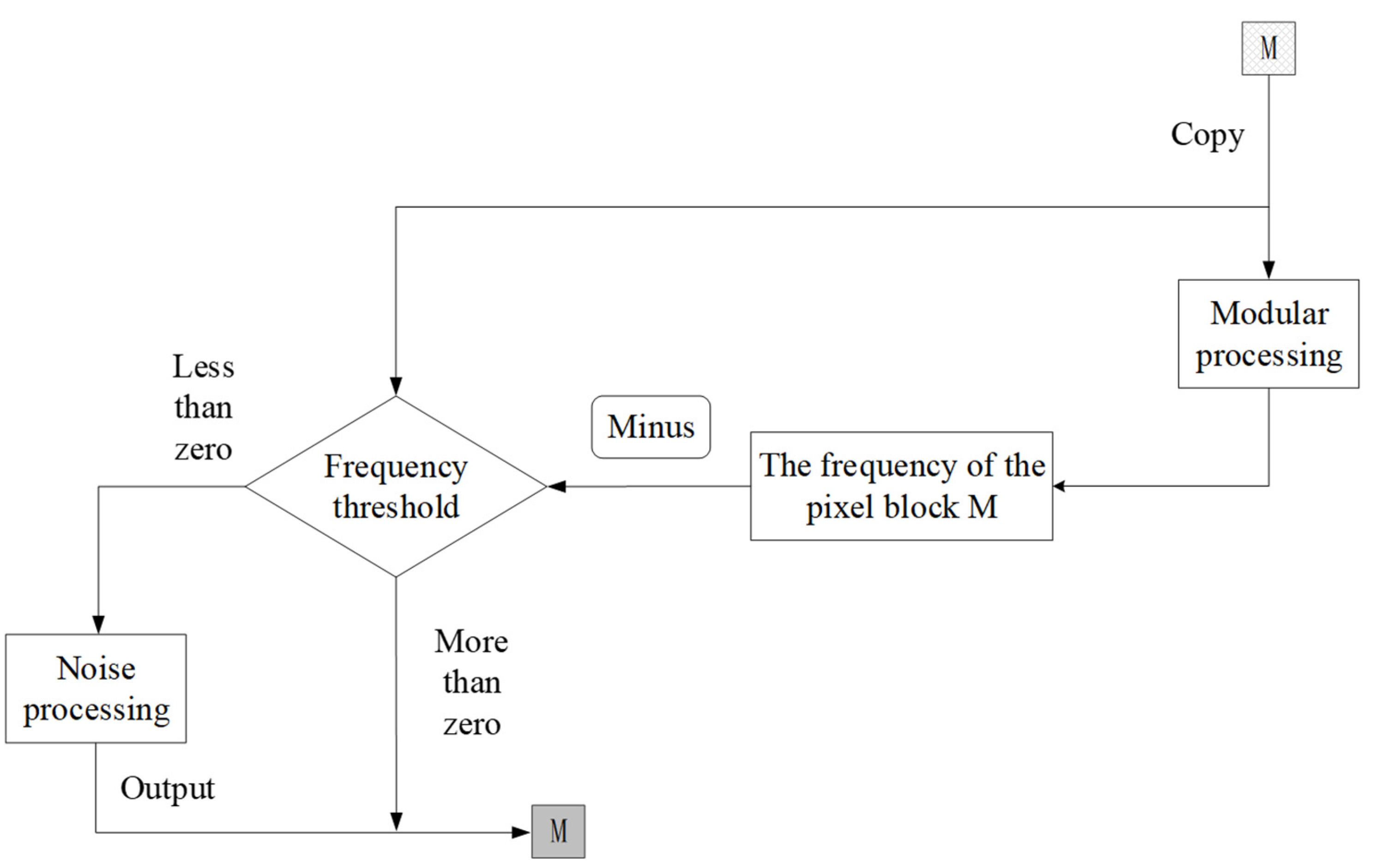
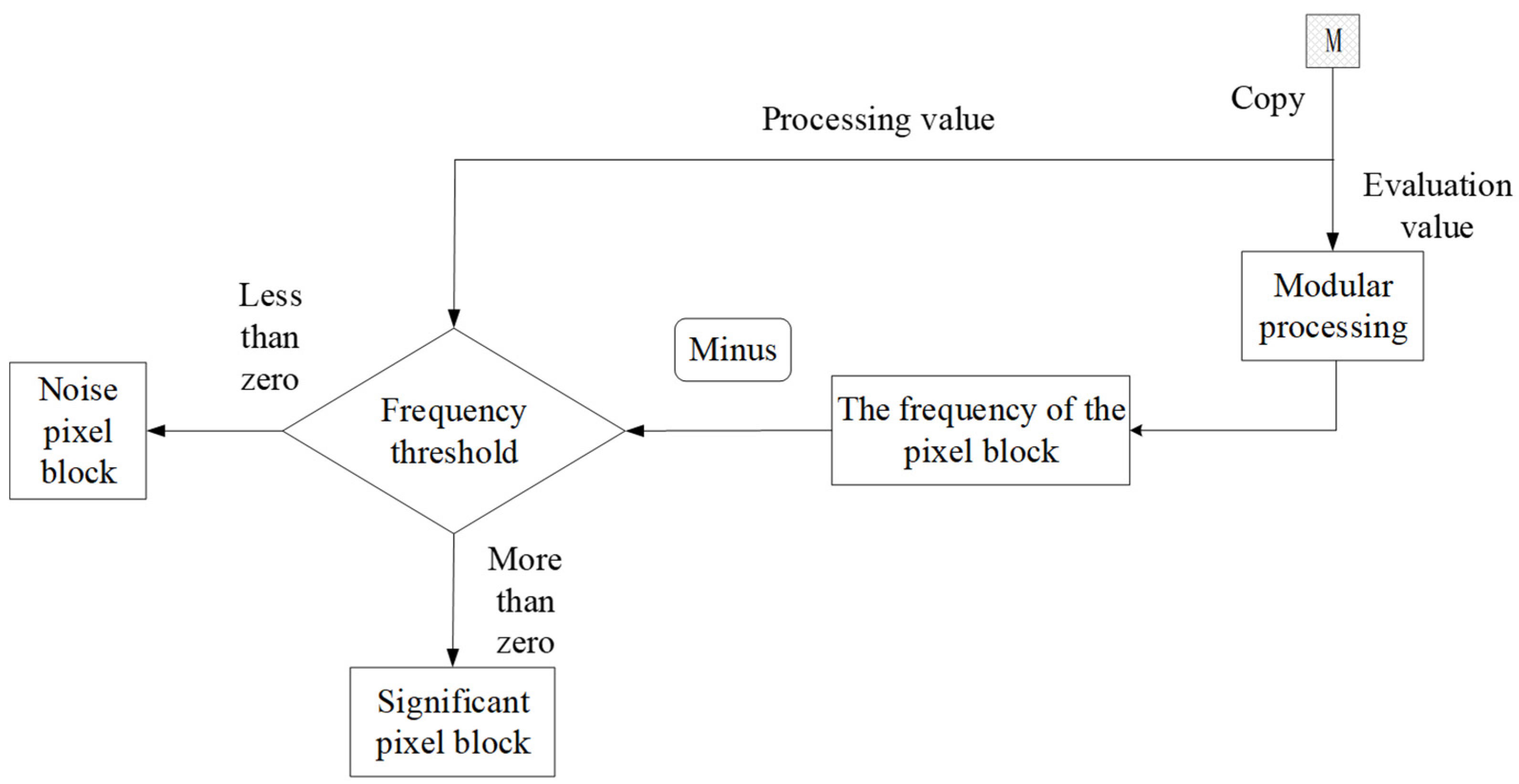


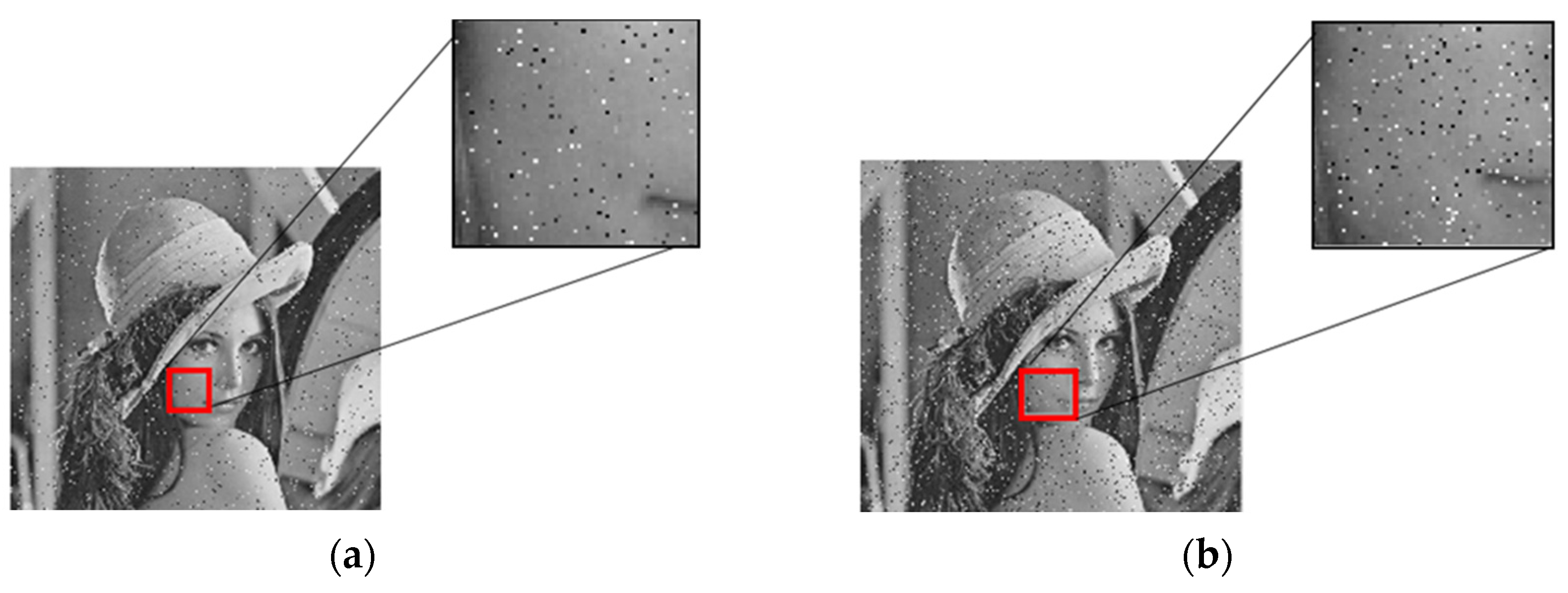

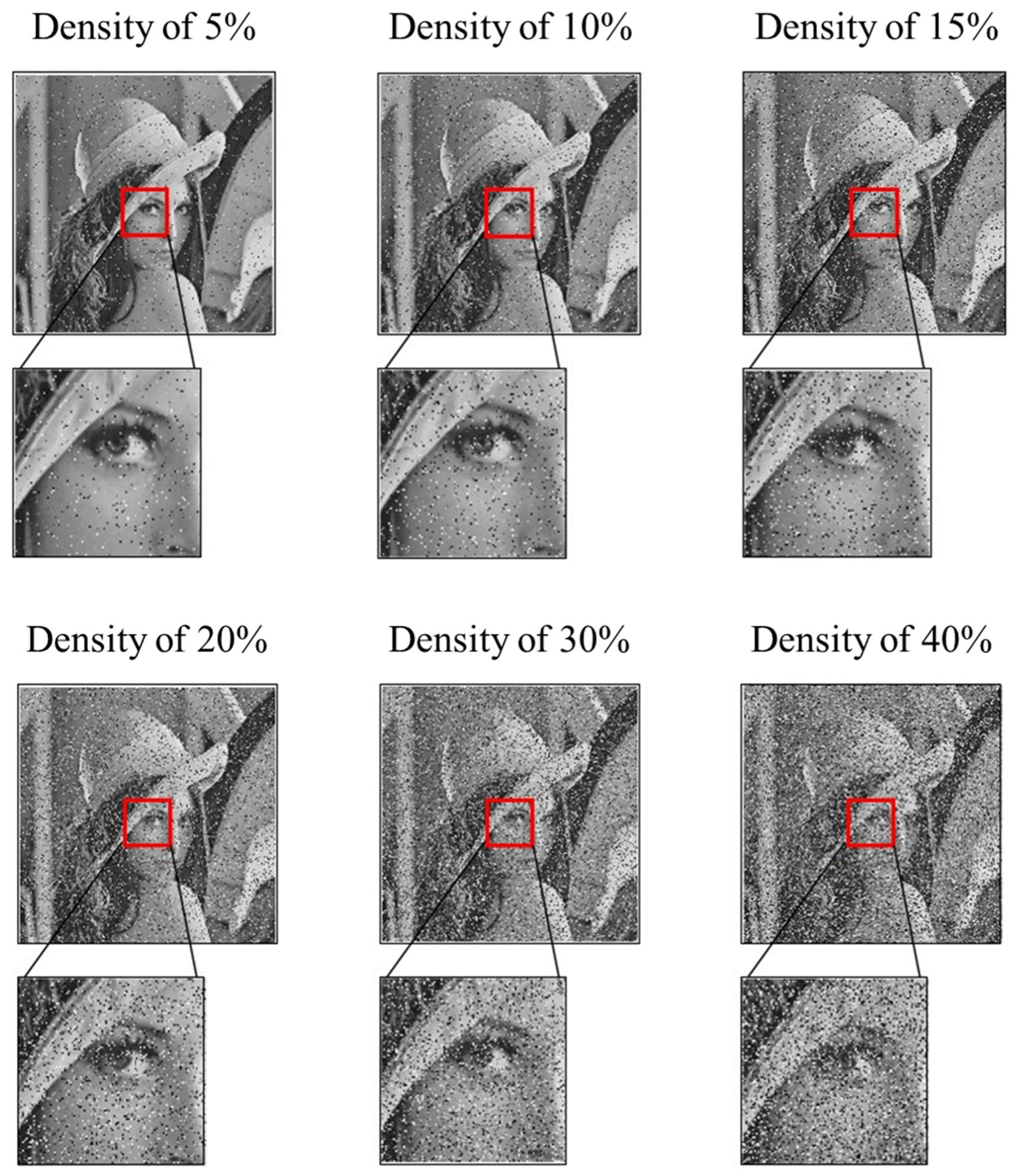
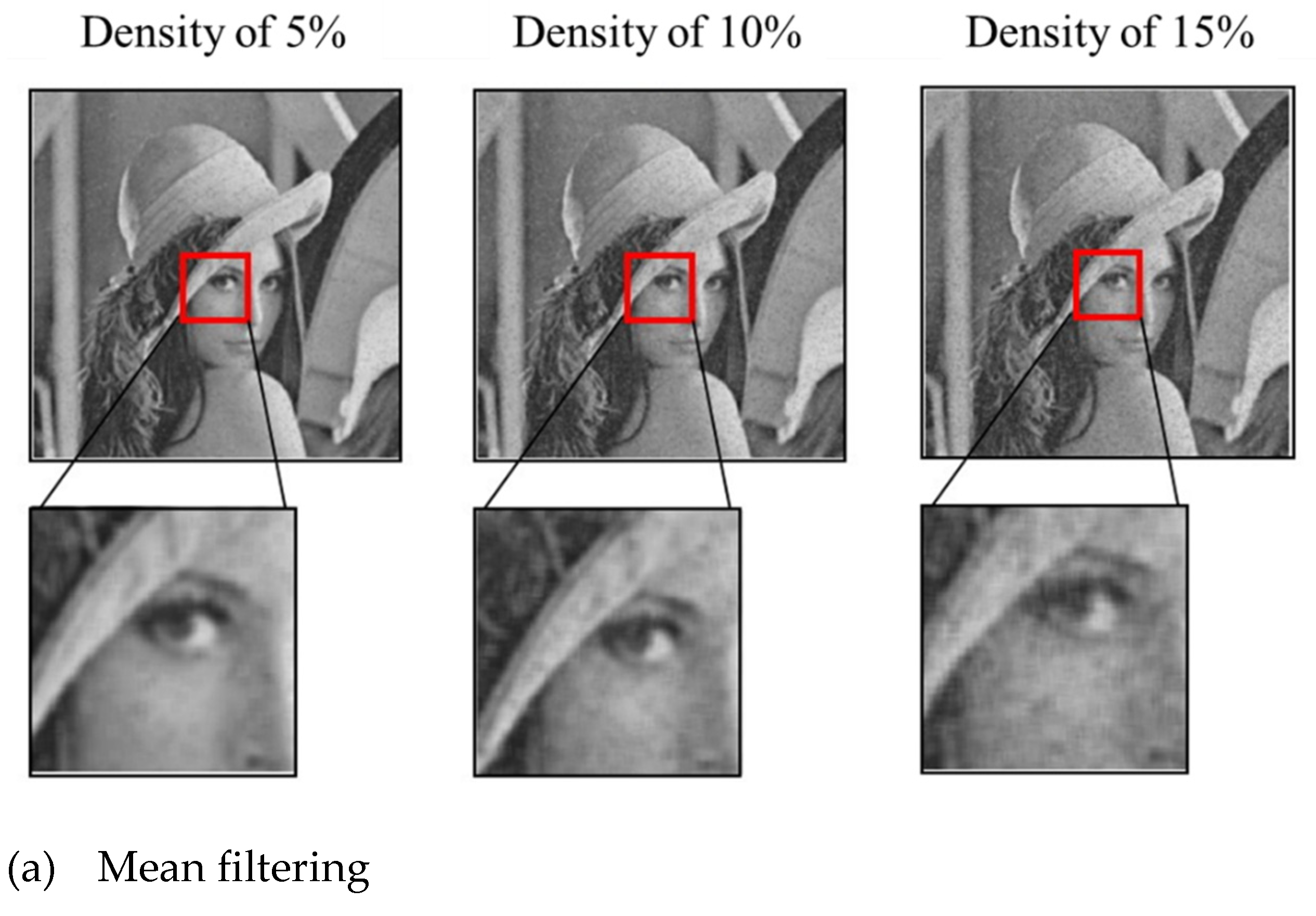


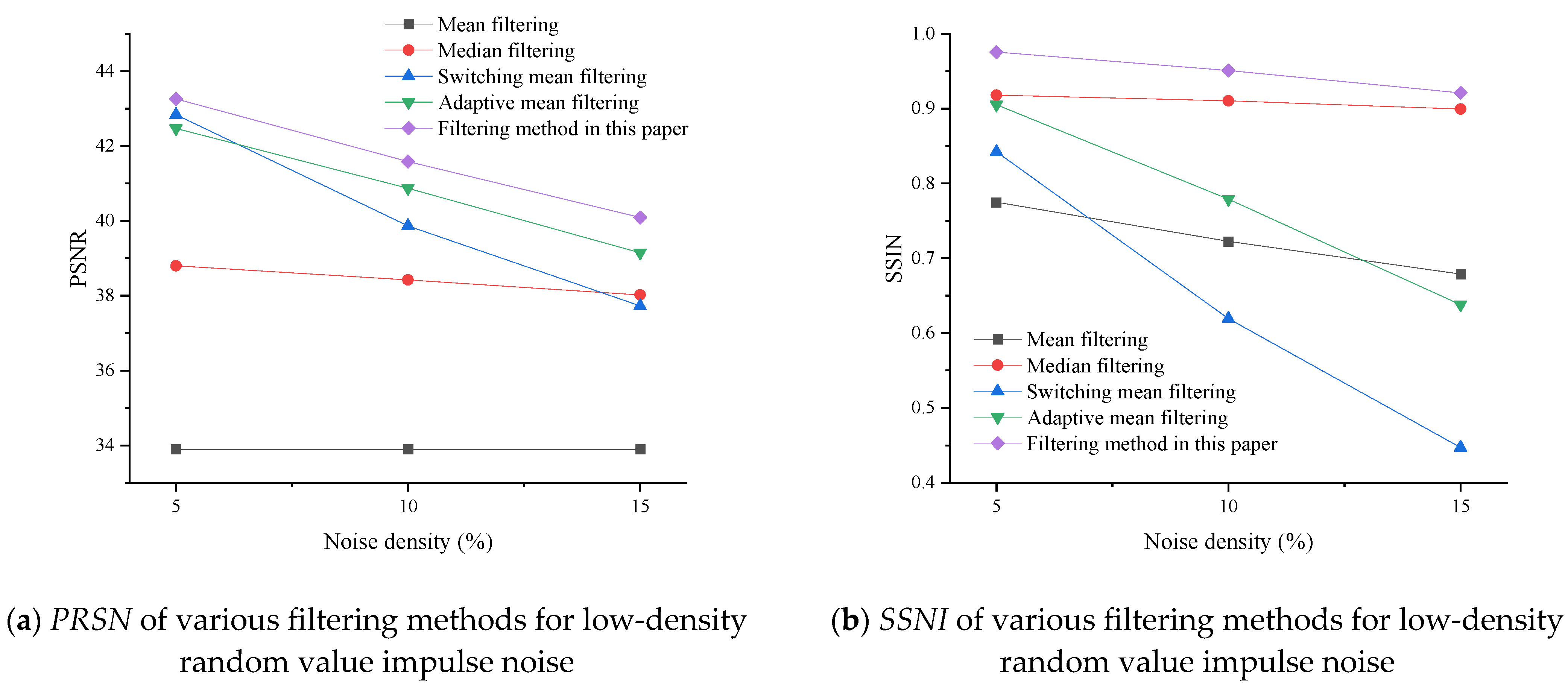
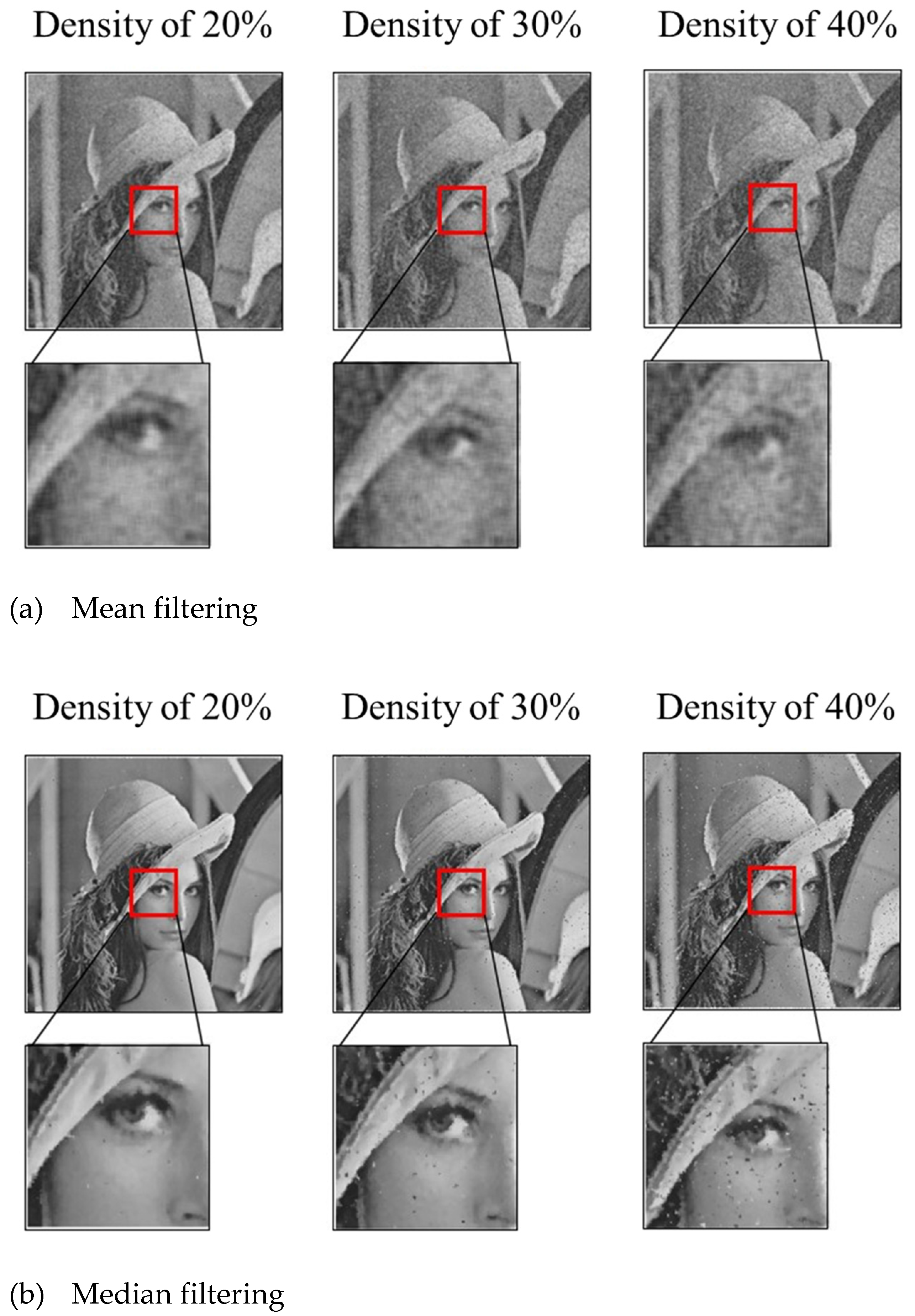

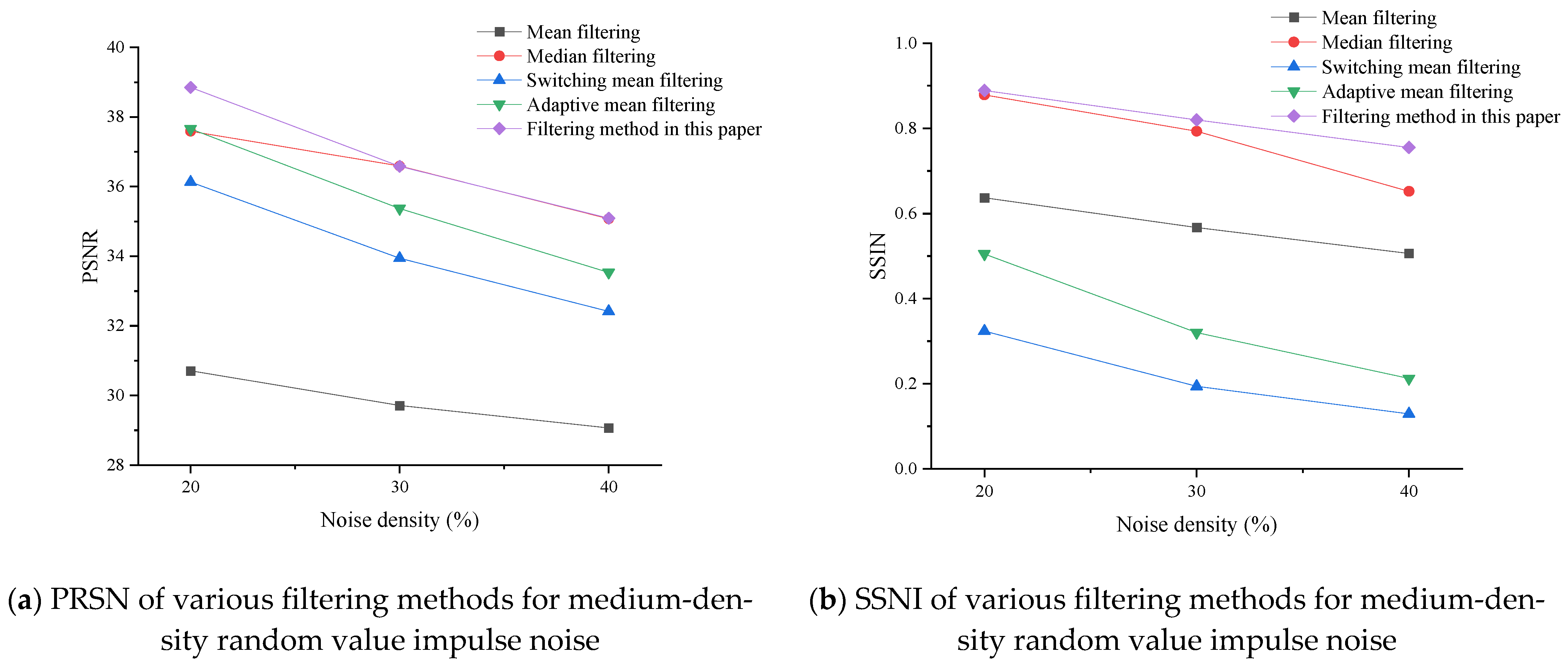
| Gray Image | Picture Size | Content | Format |
|---|---|---|---|
| Lena | 512 × 512 | Portrait | BMP |
| Noise Density | Evaluation Criteria | Mean Filtering | Median Filtering | Switching Mean Filtering | Adaptive Mean Filtering | Filtering Method in This Paper |
|---|---|---|---|---|---|---|
| 5% | PSNR | 33.8915 | 38.8005 | 42.8376 | 42.4698 | 43.2589 |
| SSIM | 0.7750 | 0.9182 | 0.8422 | 0.9053 | 0.9756 | |
| 10% | PSNR | 33.8915 | 38.4237 | 39.8674 | 40.8705 | 41.5853 |
| SSIM | 0.7228 | 0.9106 | 0.6193 | 0.7789 | 0.9510 | |
| 15% | PSNR | 33.8915 | 38.0209 | 37.7253 | 39.1448 | 40.0889 |
| SSIM | 0.6790 | 0.8995 | 0.4470 | 0.6381 | 0.9210 |
| Noise Density | Evaluation Criteria | Mean Filtering | Median Filtering | Switching Mean Filtering | Adaptive Mean Filtering | Filtering Method in This Paper |
|---|---|---|---|---|---|---|
| 20% | PSNR | 30.7087 | 37.5883 | 36.1316 | 37.6569 | 38.8521 |
| SSIM | 0.6370 | 0.8788 | 0.3237 | 0.5049 | 0.8890 | |
| 30% | PSNR | 29.7099 | 36.5909 | 33.9436 | 35.3701 | 36.5846 |
| SSIM | 0.5670 | 0.7935 | 0.1938 | 0.3201 | 0.8200 | |
| 40% | PSNR | 29.0658 | 35.0756 | 32.4166 | 33.5336 | 35.0944 |
| SSIM | 0.5061 | 0.6523 | 0.1291 | 0.2123 | 0.7551 |
Publisher’s Note: MDPI stays neutral with regard to jurisdictional claims in published maps and institutional affiliations. |
© 2022 by the authors. Licensee MDPI, Basel, Switzerland. This article is an open access article distributed under the terms and conditions of the Creative Commons Attribution (CC BY) license (https://creativecommons.org/licenses/by/4.0/).
Share and Cite
Li, Z.; Luo, T.; Lv, Y.; Guo, T.; Lin, T. A Digital Denoising Method Based on Data Frequency Statistical Filtering. Appl. Sci. 2022, 12, 12740. https://doi.org/10.3390/app122412740
Li Z, Luo T, Lv Y, Guo T, Lin T. A Digital Denoising Method Based on Data Frequency Statistical Filtering. Applied Sciences. 2022; 12(24):12740. https://doi.org/10.3390/app122412740
Chicago/Turabian StyleLi, Zhongshen, Tao Luo, Yuan Lv, Tong Guo, and Tianliang Lin. 2022. "A Digital Denoising Method Based on Data Frequency Statistical Filtering" Applied Sciences 12, no. 24: 12740. https://doi.org/10.3390/app122412740
APA StyleLi, Z., Luo, T., Lv, Y., Guo, T., & Lin, T. (2022). A Digital Denoising Method Based on Data Frequency Statistical Filtering. Applied Sciences, 12(24), 12740. https://doi.org/10.3390/app122412740







